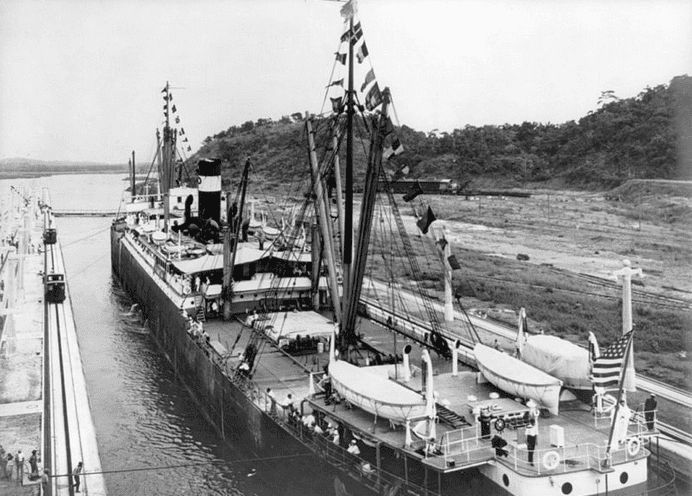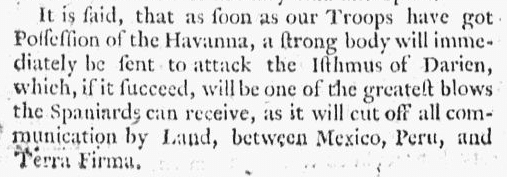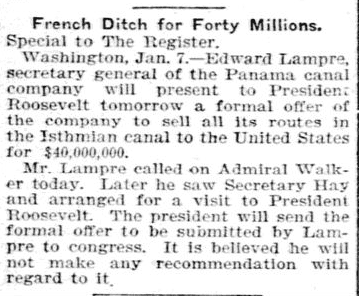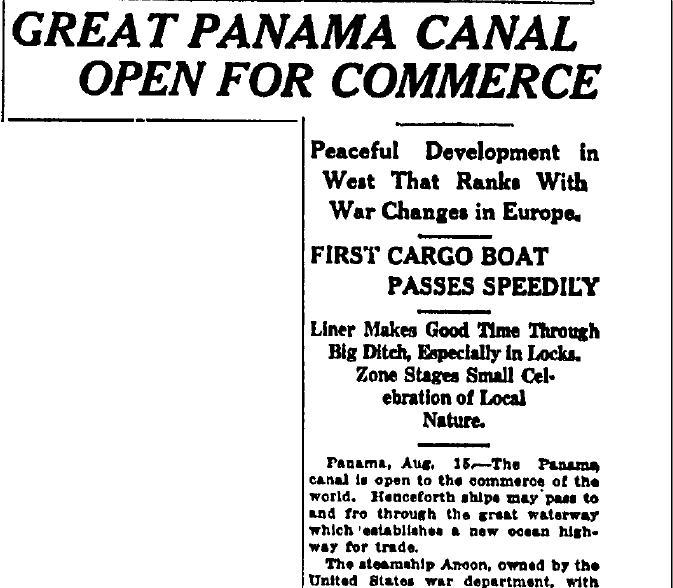100th Anniversary of the Panama Canal: History in the News was originally published at .
Introduction: Duncan Kuehn is a professional genealogist with over eight years of client experience. She has worked on several well-known projects, such as “Who Do You Think You Are?” and researching President Barack Obama’s ancestry. In this blog post, Duncan searches old newspapers to learn more about one of humankind’s greatest engineering feats: the building of the Panama Canal.
The Panama Canal recently turned 100 years old. This prompted me to learn more about the history of this important waterway.

Photo: SS Ancon passing through the Panama Canal on 15 August 1914, the first ship to use the canal. Source: Library of Congress, Prints and Photographs Division.
Early Transportation History
The only way for ships in the Atlantic Ocean to access the western coast of the Americas was to go the long way round—either around the southern tip of South America, or an even longer distance around the horn of Africa. Either route was fraught with danger and took an exceptionally long time. The narrow neck of land connecting North and South America was quickly targeted as a possible transportation alternative.
In the 1500s, Spain was particularly interested in reducing the amount of time it took to transport silver mined in Peru to Atlantic fleets. This would give them an economic and militaristic advantage over their enemies and rivals. To accomplish this, they created a trail system across the Isthmus of Panama—Spanish fleets shipped the silver from Peru to the west coast of Panama, and mule trains followed the trails to the east coast, bringing the silver to waiting ships. It wasn’t fast and it wasn’t easy, but it was better than nothing.
The Darien Disaster
Later, Scotland launched an early attempt to gain economic advantage by creating a shortcut for goods across the Isthmus of Panama. They wagered an absurd amount of money on the project termed the “Darien Scheme” (and later renamed the “Darien Disaster”). They set up an outpost in 1698 in the hopes of creating an overland route to transport goods and shorten the amount of time it took to carry items from Europe to the western coast. Conditions in the area were vastly different from what they were prepared for and horribly inhospitable. They slugged it out for less than two years before abandoning the project.
Meanwhile, the Spanish continued their efforts to make an even better route across Panama to maintain their economic success—and their enemies took notice. This 1762 newspaper article foretold “our” (British) troops’ plans to attack the Isthmus of Darien (Panama) and thwart the Spanish advantage.
The Spanish were persistent in their efforts and, as this article reported, they had established a new colony in the Isthmus of Panama by 1777.
The Panama Railroad
By the time gold was discovered in California in 1848, the railroad was a significant technological advancement. Naturally, this idea was applied in Panama: build a railroad across this challenging terrain to quickly transport goods and prospectors from the East coast and Europe and deposit them on the Pacific coast, to complete their journey by ship. They used old Spanish trails that had been in use for over three centuries.
Actually, the idea of a railroad across Panama had been in existence for many years before the California Gold Rush. The Columbian and French governments had both shown interest. The U.S. had made some effort under Andrew Jackson in the 1830s, but it wasn’t until 1855 that a cross-Panama railroad came to fruition. It is amazing that they were able to accomplish this feat. The heavens dump around 150 inches of rain each year on the landscape. Laying track in such hot, wet conditions must have been a miserable experience. But the real threat came from disease, especially malaria and yellow fever. Workers dropped like flies. Completing the Panama Railway was certainly a cause for celebration.
However, traversing the troublesome landmass necessitated loading and unloading cargo, a painfully labor- and time-intensive undertaking for the railroad. There were calls for a canal through the isthmus to allow large cargo ships to alleviate this difficulty. The French rose to the occasion and dispatched the famous Ferdinand de Lesseps—designer of the newly completed Suez Canal—to lead their nation to triumph. They rushed to start the project in 1881, without sufficient understanding of the geology or hydrology of the area.
At first the idea was simply to cut away the land leaving a sea level passageway. Attempts at this seemingly simple idea soon showed that the copious rainfall quickly filled these efforts of the exhausted laborers, with mud and large landslides causing problems. The wedge of land to be removed changed from a narrow slip, just wide enough to allow a ship’s passage, to an impossibly large width to prevent the frequent landslides. This was all being attempted with primitive steam shovels that quickly rusted to uselessness in the persistent rain. If that wasn’t disheartening enough, the swampy conditions were ripe for mosquitoes and therefore deadly malaria and yellow fever. Thousands of workers died and the project went bankrupt. Meanwhile, the American media had a heyday over the “Panama Canal Fiasco” or the “Panama Affair.”
Despite a later attempt to revive the project, the weary French eventually sold out to America for a bargain basement price.
After the smoke had cleared from the expected congressional infighting over the viability of the project and the wisdom of purchasing the project from the French, there remained the matter of obtaining Colombian authorization (Panama was Columbian territory at the time).
When Columbia refused to ratify a treaty granting such permission, President Theodore Roosevelt and the U.S. got around this obstacle by promising support to Panamanian rebels seeking independence from Columbia. U.S. warships moved into position off the Panamanian coast on 2 November 1903, and Panama declared independence the next day. Three days later, on 6 November 1903, the newly-recognized nation of Panama signed a treaty granting the U.S. the right to build and administer a canal.
With that, the U.S. got to work. Fortunately, by that time technology had advanced and we were able to complete the project by building a lock system—but not before even more people died of illness and accident. (As a side note, it is good to know that the Panama Affair did contribute to a better understanding of mosquito-borne illnesses and their prevention.)
Panama Canal Opens
After much labor, the Herculean task of building the Panama Canal was completed, and it was officially opened on 15 August 1914.
Of course, this is a simplified and selective account of the scandal-soaked history of the canal. It doesn’t mention that the treaty we signed with Columbia (which was refused by that country) was actually with a French representative. It doesn’t detail the behind-the-scenes maneuvering that the U.S. was involved in with the rebellion that created the country of Panama—all in order to accomplish our goal of building the canal. It doesn’t mention the Panamanian protests after WWII and international pressure which led—eventually—to the release of the canal to Panama beginning in 2000. Nor does it go in depth into the scandals, illnesses, and accidents that make a study of the canal so interesting.
Hopefully, this article gives a little insight into the history of the Panama Canal and whets your appetite for your own research. The significance of the Panama Canal cannot be overstated. World commerce depends on fast, dependable transportation, which the canal provides.
Also, it is hoped that this article offers insights into what can be found in and learned from the old newspapers contained in GenealogyBank’s online Historical Newspaper Archives.
Related Articles about Early Transportation:
100th Anniversary of the Panama Canal: History in the News is a post from: GenealogyBank Genealogy Blog. Visit GenealogyBank to trace your family tree online.
Get more great genealogy tips and tools at and be sure to visit Genealogy Bank to start researching your ancestry online.






